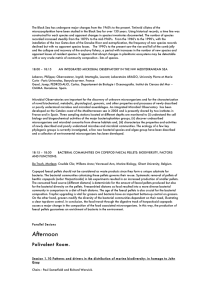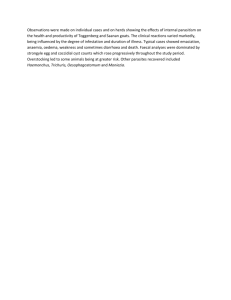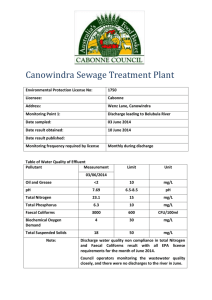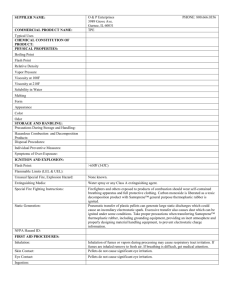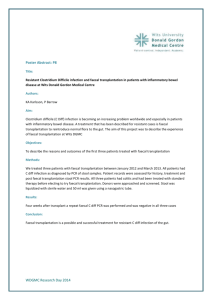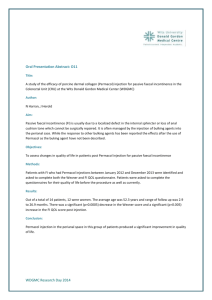FAECAL P E L L E T S 162
advertisement
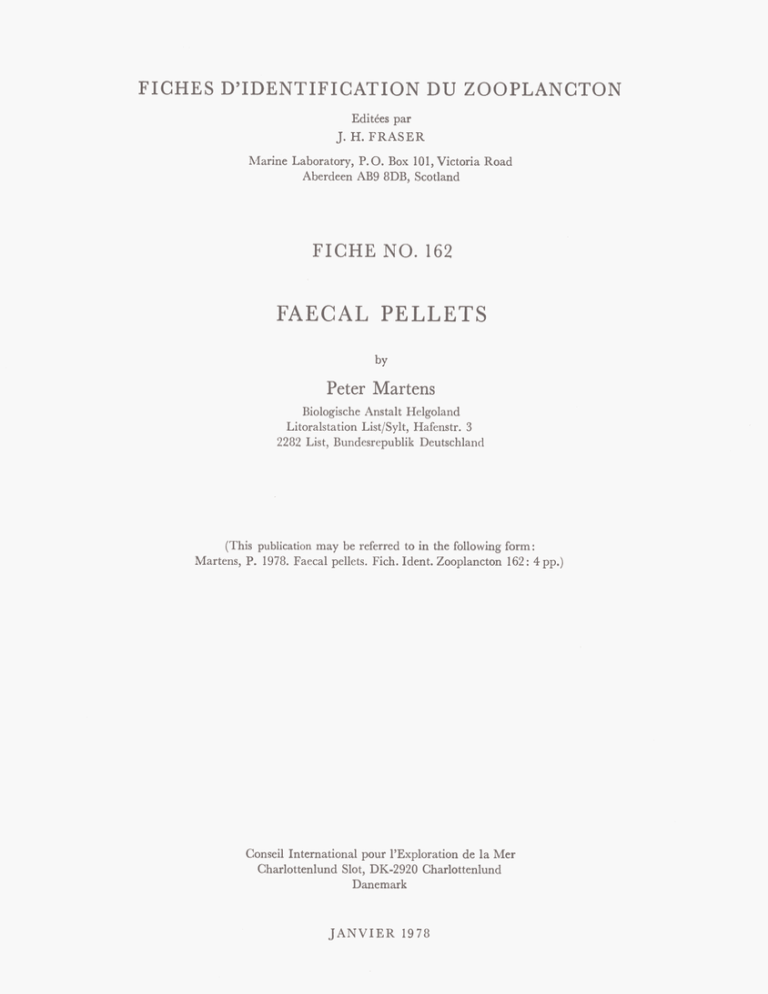
F I C H E S D’IDENTIFICATION D U ZOOPLANCTON EditCes par J. H. FRASER Marine Laboratory, P. 0. Box 101, Victoria Road Aberdeen AB9 8DB, Scotland F I C H E NO. 162 FAECAL PELLETS Peter Martens Biologische Anstalt Helgoland Litoralstation List/Sylt, Hafenstr. 3 2282 List, Bundesrepublik Deutschland (This publication may be referred to in the following form: Martens, P. 1978. Faecal pellets. Fich. Ident. Zooplancton 162 : 4 pp.) Conseil International pour 1’Exploration de la Mer Charlottenlund Slot, DK-2920 Charlottenlund Danemark J A N V I E R 1978 2 i0 a: a! 1 2 8 9 '0 7 6 OJ1mm c:. OJ5mm d e: mm 0 Faecal pellets of some planktonic crustaceans and benthic invertebrates. a: Faecal pellets of CalanusJnmarchicus. 1 and 2: Male and female fed on Skeletoma and Mtzschia. 3 and 4 : Male and female fed on Skeletonema. 5 and 6 : Male and female fed on Ditylum. 7 and 8 : Unknown food source. 9 and 10: Animals fed on Biddulphia. b: Faecal pellets of Meganyctiphunes nosvegica. Note the crustacean spines in the left faecal pellet. c: Faecal pellets of Centropages humatus (with tail piece). f: Faecal pellets of Oithona similis. d: Faecal pellets of Pseudocalanus elongatus. g : Benthic pellets: Faecal pellets of Maldanid-Rhodine sp. e: Faecal pellets of Acastia b9losa. h: Benthic pellet: Faecal pellet of Syndosmia alba. 3 Faecal pellets There are many plankton research programmes in which a knowledge of faecal pellets would be valuable, e.g., egg productivity, food chains, etc., but present knowledge is far from satisfactory. Copepod pellets are probably the most important group. This sheet attempts to show the little information that is available, and it is also hoped that, in revealing this scarcity, it will stimulate further research into a most useful subject. Table 1. Characteristics of the faecal pellets of different planktonic crustaceans a e number of faecal pellets examined, b = mean length of faecal pellets, c = mean length of the tail piece, d = length/breadth, f = characteristic form, g = food used in the investigation. = Species Calanus Jinniarchicus 8 Calanus Jinmarchicus 9 Calanus Jinmarchicus 8 Calanus Jinmarchicus 9 Calanus Jinmarchicus 8 Calanus Jinmarchicus 9 Calanus Jinmarchicus Calanus helgolandicus Acartia biJlosa 8 Acartia biJlosa 9 Centropages hamatus 8 Centropages hamatus 9 Pseudocalanus elongatus 8 Pseudocalanus elongatus 9 Oithona similis 8 Oithona similis 9 Spicodiaptomus chelospinus Spicodiaptomus chelospinus Spicodiaptomus chelospinus Spicodiuplomus chelospinus Spicodiaptomus chelospinus Palaemonetes pugio MeganyctiphaneJ noruegica Euphausiaceae SPP. Artemia salina Artemia salina Artemia salina a b C d e f ? 550 p m - 45 ,uni 12.2 Cylindrical ? 950 p m 510 pm 180 pm 5.3 Cylindrical g Skeletonema iNitzschia Skeletonema f Nitzschia ? 520 pm - 60 p m 8.4 Cylindrical Skeletonema ? 1350 pm 130 ,urn 10.4 Cylindrical Skelelonema 80 p m 8.4 Cylindrical Ditylum = mean breadth, Author RAYMONT and GROSS,1972 ? 685 pm - ? 1200 pm 670 pm 155 ,urn 7.7 Cylindrical Ditylum ? 200-400 pm Present 50-100 p m - Cylindrical ? MOORE,1931 Biddulphia CORNER et al., 1972 2 650 p m - 100 p m 6.5 Cylindrical 132 123 pm 12 pm 34 p m 3.7 Cylindrical 192 142 ,urn 23 pm 53 pm 2.8 Cylindrical 79 110,um 39 pm 33 p m 3.3 Cylindrical 156 139 pm 43 p m 43 pm 3.3 Cylindrical 133 157 p m 21 pm 31 pm 5.2 Cylindrical 106 157 pm 22 p m 31 p m 5.2 Cylindrical 62 36 pm 26 p m 1.5 Ellipsoid 181 36 pm 26 ,um 1.5 Ellipsoid ? 250 pm 77 pm 3.3 ? ? 288 pm 68 pm 4.2 ? ? 385 pm 74 pm 5.2 ? ? 115,um 58 pm 2.0 ? ? 269 pm 64 ,urn 4.2 ? ? 1-20 mm 50-200 ,urn - Cylindrical ? U p to 4 mm 100-150 p m - Cylindrical ? L 040-7 300 p m 48-1 76 p m 9-65 Cylindrical Phyto- and zooplankton powder Zooplankton powder Ground filamentous green algae Groundnut cake powder Coloured filterpaper powder Nitzschia closterium Mainly crustaceans “Natural food” 10 1250 p m 390 p m 3.2 Cylindrical Phaeodactylum 10 1530 pm 425 p m 3.6 Cylindrical Dunaliella 10 1370 urn 365 p m 3.8 Cylindrical Sand Chaetoceros decipiens iChaetoceros socialis iDetonula cystijera + Skeletonema costatum f flagellates 4pm 0 MARTENS, 1976 and SATOMI, 1966 JOHANNES MOORE,1931 FOWLER and SMALL,1972 i REEVE,1963 4 Description Shape: T h e characteristic shape of most of the faecal pellets of planktonic copepods and euphausiids is a cylinder with rounded ends (Calanus finmarchicus, Calanus helgolandicus, Acartia biJlosa, Centropages hamatus, Pseudocalanus elongatus) or often frayed ends (Meganyctiphanes noruegica) (MOORE,1931). T h e surrounding membrane can form a tail piece, and the frequency of occurrence is different in the different species (Acartia, 11 %; Pseudocalanus, 30 %; Centropages, 50 76) (MARTENS, 1976). No tail piece could be found on the faecal pellets of male Calanusjnmarchicus. The mean length of the faecal pellets is relatively great compared with the et al., breadth, with the ratio of length to breadth of the faecal pellets of Calanus spp. varying between 6: 1 and 10: 1 (CORNER 1972). I n euphausiids it even varies between 9 : 1 and 65: 1 (FOWLERand SMALL,1972). The faecal pellets of the cyclopoid Oithona similis are characteristically ellipsoid in shape and without tail pieces. The mean ratio of length to breadth is 1.4: 1. This resembles the type of some faeces of benthic origin described by MOORE(1931), as for Syndosmia alba or for a young maldanid worm, with a length to breadth ratio of 1.6: 1 and a characteristically oval to ellipsoid shape. The faecal pellets of the benthic animals are much larger, so confusion with planktonic faeces (length 500-750 pm) is unlikely. They have a brownish, massive non-transparent structure, whereas the faecal pellets of the planktonic species are of a grcenish brown, more transparent structure. Size: The length and breadth of the faecal pellets of a single species may vary even if a constant source of food is maintained. The length of faeces of Acartia biJlosa varied between 50 and 240 p m ; Oithona similis, 20-80 pm; Centropages hamatus, 50-200 p m ; and Pseudocalanus elongatus, 50-270 p m (MARTENS,1976). With different sources of food the size also varies, and for Palaemonetes pugio by as much as 2000 % (JOHANNES and SATOMI,1966) ! The mean values of length and breadth of the faecal pellets of the species mentioned above show significant differences (MARTENS, 1976), so that a n analysis of the distributive function of length or breadth of a natural “faecal pellet population” should lead to a specific identification on the species level. The size and shape of faeces of mainly carnivorous species (e.g. euphausiids) may be affected by indigestible remains of food, e.g., large crustacean spines (MOORE,1931). The faecal pellets of the males of some species were normally smaller than those of the females (Acartia bglosa, Centropages hamatus, Calanusfinmarchicus) (RAYMONT and GROSS,1942; MARTENS,1976). REFERENCES ABDULKADER,H., 1975. Observations on the production of faecal pellets in Spicodiaptomus chelospinus Rajendran (Copepoda: Calanoida). Indian J. Ecol., 2.: 188-189. CORNER, E. D. S., HEAD,R. N., and KILVINGTON, C. C., 1972. O n the nutrition and metabolism of zooplankton, VIII. The grazing of Biddulphia cells by Calanus helgolandicus. J. mar. biol. Ass. U.K., 52 : 847-861. FOWLER,S. W., and SMALL,L. F., 1972. Sinking rates of euphausiid fecal pellets. Limnol. Oceanogr., 17 : 293-296. JOHANNES, R.E., and SATOMI,M., 1966. Composition and nutritive value of fecal pellets of a marine crustacean. Limnol. Oceanogr., 11 : 191-197. P., 1976. Artspezifische Merkmale der Faeces von MARTENS, vier dominierenden Copepodenarten der Kieler Bucht. Helgolander wiss. Meeresunters., 28: 41 1-416. MOORE,H. B., 1931. The specific identification of faecal pellets. J. mar. biol. Ass. U.K., 17: 359-365. RAYMONT, J. E. G, and GROSS,F., 1942. O n the feeding and breeding of Calanus finmarchicus under laboratory conditions. Proc. R. Soc. Edinb., 61 : 267-287. REEVE,M. R., 1963. The filter feeding of Artemia. 111. Faecal pellets and their associated membranes. J. exp. Biol., 40: 2 15-22 1. Printed in Denmark BlANrn LLNR m.I(BH
